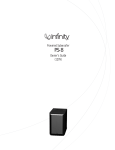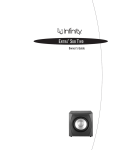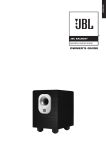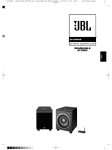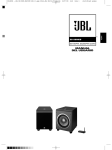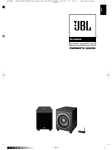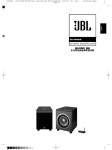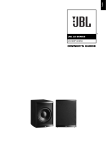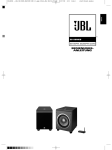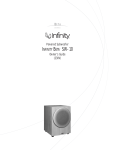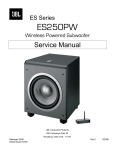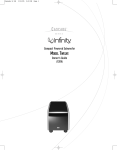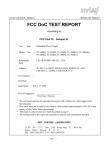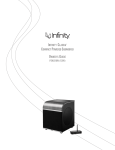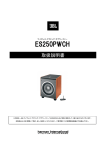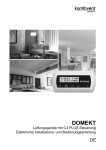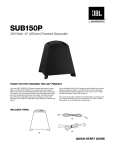Download JBL ES150PW User's Manual
Transcript
JBLP2706_ES150-250PW-120om 5/20/08 4:15 PM Page 1 ® ES SERIES ES150PW, ES250PW (120V) OWNER’S GUIDE JBLP2706_ES150-250PW-120om 5/20/08 4:15 PM Page 2 IMPORTANT SAFETY PRECAUTIONS Read First! 1. Read these instructions. 2. Keep these instructions. 3. Heed all warnings. 4. Follow all instructions. 5. Do not use this apparatus near water. 6. Clean only with a dry cloth. 7. Do not block any ventilation openings. Install in accordance with the manufacturer’s instructions. 8. Do not install near any heat sources such as radiators, heat registers, stoves or other apparatus (including amplifiers) that produce heat. 9. Do not defeat the safety purpose of the polarized or groundingtype plug. A polarized plug has two blades with one wider than the other. A grounding-type plug has two blades and a third grounding prong. The wide blade or the third prong is provided for your safety. If the provided plug does not fit into your outlet, consult an electrician for replacement of the obsolete outlet. 10. Protect the power cord from being walked on or pinched, particularly at plugs, convenience receptacles and the point where they exit from the apparatus. 11. Only use attachments/accessories specified by the manufacturer. 12. Use only with the cart, stand, tripod, bracket or table specified by the manufacturer or sold with the apparatus. When a cart is used, use caution when moving the cart/ apparatus combination to avoid injury from tip-over. 13. Unplug this apparatus during lightning storms or when unused for long periods of time. 14. Refer all servicing to qualified service personnel. Servicing is required when the apparatus has been damaged in any way, such as power supply cord or plug is damaged, liquid has been spilled or objects have fallen into the apparatus, or the apparatus has been exposed to rain or moisture, does not operate normally or has been dropped. 15. Do not expose this apparatus to dripping or splashing and ensure that no objects filled with liquids, such as vases, are placed on the apparatus. 16. To completely disconnect this apparatus from the AC Mains, disconnect the power supply cord plug from the AC receptacle. 17. The mains plug of the power supply cord shall remain readily operable. 18. Do not expose batteries to excessive heat such as sunshine, fire or the like. The lightning flash with arrowhead symbol, within an equilateral triangle, is intended to alert the user to the presence of uninsulated “dangerous voltage” within the product’s enclosure that may be of sufficient magnitude to constitute a risk of electric shock to persons. The exclamation point within an equilateral triangle is intended to alert the user to the presence of important operating and maintenance (servicing) instructions in the literature accompanying the product. WARNING: To reduce the risk of fire or electric shock, do not expose this apparatus to rain or moisture. FEDERAL COMMUNICATIONS COMMISSION INTERFERENCE STATEMENT This equipment has been tested and found to comply with the limits for a Class B digital device, pursuant to Part 15 of the FCC Rules. These limits are designed to provide reasonable protection against harmful interference in a residential installation. This equipment generates, uses and can radiate radio frequency energy and, if not installed and used in accordance with the instructions, may cause harmful interference to radio communications. However, there is no guarantee that interference will not occur in a particular installation. If this equipment does cause harmful interference to radio or television reception, which can be determined by turning the equipment off and on, the user is encouraged to try to correct the interference by one of the following measures: • Reorient or relocate the receiving antenna. • Increase the separation between the equipment and receiver. • Connect the equipment into an outlet on a circuit different from that to which the receiver is connected. • Consult the dealer or an experienced radio/TV technician for help. FCC Caution: To assure continued compliance, any changes or modifications not expressly approved by the party responsible for compliance could void the user’s authority to operate this equipment. (Example – use only shielded interface cables when connecting to computer or peripheral devices.) FCC Radiation Exposure Statement This equipment complies with FCC RF radiation exposure limits set forth for an uncontrolled environment. This equipment should be installed and operated with a minimum distance of 20 centimeters between the radiator and your body. This device complies with Part 15 of the FCC Rules. Operation is subject to the following two conditions: (1) This device may not cause harmful interference, and (2) This device must accept any interference received, including interference that may cause undesired operation. JBLP2706_ES150-250PW-120om 5/20/08 4:15 PM Page 3 INTRODUCTION PLACEMENT ES150PW/ES250PW Wireless Powered Subwoofers Since the installation of a subwoofer can be somewhat more complicated than installing full-range speakers, it is essential that you read this section very carefully prior to connecting the subwoofer to your system. Should you have questions relating to your installation, it is advisable to contact either your dealer or the JBL Customer Service Department for advice. For more than 60 years, JBL® audio equipment has been used in concert halls, recording studios and movie theaters around the world, and become the hands-down choice of leading recording artists and sound engineers. With the JBL ES Series, innovative technologies such as titanium-laminate-dome tweeters, Elliptical Oblate Spheroidal™ (EOS) waveguides and PolyPlas™ transducer reinforcement are available to you. In addition, the ES150PW/ES250PW’s compact enclosure and wireless capability allow for easy integration into any residential environment. Enjoy! Unpacking the Subwoofer If you suspect damage from transit, report it immediately to your dealer. Keep the shipping carton and packing materials for future use. Included 1 x Owner’s manual 1 x USA warranty sheet 1 x Subwoofer 1 x 15' Audio cable, RCA-RCA 1 x Transmitter module 1 x Power supply for transmitter 1 x 120V AC power cord for transmitter power supply The performance of the subwoofer is directly related to its placement in the listening room and how you align the subwoofer with its satellite speakers. The ES150PW/ES250PW’s wireless capability makes it even easier to properly locate the subwoofer in your room. Setting the volume of the subwoofer in relation to the left and right speakers is also of critical importance because it is essential that the subwoofer integrate smoothly with the entire system. Setting the subwoofer’s volume level too high will result in an overpowering, boomy bass. Setting the volume level too low will negate the benefits of the subwoofer. Here are several additional facts on installation that may prove useful. It is generally believed by most audio authorities that low frequencies (below 125Hz) are nondirectional and, therefore, placement of a subwoofer within any listening room is not critical. While in theory it is true that the larger wavelengths of extremely low frequencies are basically nondirectional, the fact is that, when installing a subwoofer within the limited confines of a room, reflections, standing waves and absorptions generated within the room will strongly influence the performance of any subwoofer system. As a result, the specific location of the subwoofer becomes important, and it is strongly recommended that you experiment with placement before choosing a final location. Placement will depend upon your room and the amount and quality of bass required (for example, whether or not your room permits placement of the subwoofer near either satellite). 1 x 6' Audio cable, RCA-RCA 1 x Wall-mount bracket for transmitter (with two pan-head M3 x 4 machine screws for attaching wall-mount bracket to transmitter) 4 x Small, round, self-adhesive feet – to be attached on transmitter’s left side panel if transmitter is to be used vertically SUB RIGHTCHANNEL SPEAKER PRIMARY LISTENING AREA Figure 1. This example shows the subwoofer positioned behind the right-channel satellite speaker to re-create the actual location of bass instruments in an orchestra and/or add impact to movie soundtracks. 3 JBLP2706_ES150-250PW-120om 5/20/08 4:15 PM Page 4 CONTROLS AND CONNECTIONS Rear Panel ¡ Power Switch ™ Line-Level Inputs £ LFE Input ¢ Low-Pass Selector (Wireless Input Only) ∞ ID-Code Selector Phase Antenna § Crossover Adjustment Control • ª ¶ Subwoofer-Level (Volume) Control Level • Phase Switch ¶ ª Wireless Antenna Crossover [Hz] ∞ § Transmitter ‚ Transmitter Antenna Wireless ⁄ Transmitter Power-Supply Input Off ID Code On B Transmitter ID-Code Selector Low-Pass ¢ ™ £ R L ‹ Transmitter Sub Input LFE Sub In Power On ¡ Off AC 120V~60Hz 2A ID CODE DC18V 1 2 3 4 ‚ 4 ⁄ B Sub In ‹ JBLP2706_ES150-250PW-120om 5/20/08 4:15 PM Page 5 SYSTEM CONNECTIONS Choose either Wireless or Wired connection, then follow the appropriate instructions. WIRELESS WIRED Connecting the Subwoofer for Wireless Applications Connecting the Subwoofer for Wired Applications If you have a Dolby® Digital or DTS® receiver/processor with a low-frequency effects (LFE) or subwoofer output: Level Crossover [Hz] ID CODE DC18V 1 2 3 4 Sub In 1. Connect a subwoofer cable from the subwoofer or LFE output of your receiver to the Sub In C on the transmitter. 2. Plug the transmitter module’s power supply into the wall outlet, and connect the included power cord to the transmitter A. Make sure the Transmitter Antenna ‚ is extended upward. Wireless O Offff ID Code OOnn Low-Pass Low-Pass L Sub In R LFE Line In 3. Set the ID code on the transmitter and subwoofer (B and ∞) to the same position, as described on page 6. When connected properly, the LED on the top of the subwoofer will be orange. 4. Set the Low-Pass Selector ¢ to the “Off” position. NOTES: You may also connect a variable full-range output from an A/V receiver or processor, such as a preamp output or second-room output. In this case, set the Low-Pass Selector ¢ to the “On” position and set the crossover adjustment as described on page 6. If your receiver/processor does not contain a Dolby Digital or DTS processor but has subwoofer outputs: Some receivers have two subwoofer outputs. In that case, use either connector. Level Crossover [Hz] Wireless Off ID Code On Low-Pass L Sub In R LFE Line In NOTE: If your receiver/processor has only one sub out, you may use either the L or R input. 5 JBLP2706_ES150-250PW-120om 5/20/08 4:15 PM Page 6 OPERATION Power On Connect your signal source (such as an A/V receiver or preamplifier) to the transmitter (if using a wireless connection) or to the subwoofer (if using a wired connection). Two single-RCA cords are provided. While you would ordinarily use the short cable to connect to the transmitter or the long one to connect to the subwoofer, either cable can be used, depending on proximity to the signal source. There is no need or benefit gained from connecting the same source to both the transmitter and the subwoofer. However, you could connect two separate sources to the subwoofer by utilizing both its wired and wireless connections. Both signals will essentially be mixed and outputted by the subwoofer. Plug your transmitter’s (if using a wireless connection) and subwoofer’s AC cord into a wall outlet. Do not use the outlets on the back of the receiver for the subwoofer. Initially set the Subwoofer-Level Control ¶ to the “Min” position. Turn on your sub by pressing the Power Switch ¡ on the rear panel. Turn on your entire audio system and start a CD or movie soundtrack at a moderate level. Auto On/Standby Transmitter (Wireless Connection Only): The Status LED (not shown) will be lit in red when the unit is in Standby. When the transmitter receives an audio signal from the source, it will immediately turn on and the LED will turn to blinking green or solid green: RED = STANDBY (No signal detected, transmitter off) GREEN (BLINKING) = Transmitter is on but has not established a link with the wireless sub GREEN (SOLID) = Transmitter is on and has already established a link with the wireless sub The transmitter will automatically enter Standby mode after approximately 10 minutes when no signal is detected from your system. Subwoofer: With the Power Switch ¡ in the “On”position, the Status LED on the back panel will remain lit to indicate the On/Standby mode of the subwoofer. RED = STANDBY (No signal detected, amp off) GREEN = SUB ON (Wired signal detected, amp on) ORANGE = SUB ON (Wireless link with transmitter active) The subwoofer will automatically enter Standby mode after approximately 10 minutes when no signal is detected from your system. The subwoofer will then power on instantly when a signal is detected. During periods of normal use, the Power Switch ¡ can be left on. You may turn off the Power Switch ¡ for extended periods of nonoperation (e.g., when you are away on vacation). Getting Started Confirm that the Status LED on the transmitter is on (red or green), the Status LED on the subwoofer is on (red, orange or green) and an RCA cable is connected from a source unit to either the LFE Input of the subwoofer £ or transmitter ‹ or L and R inputs ™ on the subwoofer. Play a CD or video. Use a selection that has ample bass information. If using a wireless connection, the Status LED on the transmitter should be lit in solid green, and the Status LED on the subwoofer should turn orange if connected wirelessly. If the LED on the transmitter is blinking in green and the LED on the subwoofer is in red or green, a wireless link has not been established between the transmitter and the subwoofer. If connecting directly to the subwoofer without using the wireless link, the Status LED on the subwoofer should be lit green. If the LED on the subwoofer remains red, check that the RCA cable from the source to subwoofer (wired connection) or transmitter (wireless connection) is functioning properly and that it is fully inserted at both ends, or that the Transmitter ID-Code Selector B and the Subwoofer ID-Code Selector ∞ are set to the same channel. Once you have a green or orange LED on the subwoofer, turn your Subwoofer-Level Control ¶ up halfway so that the knob indicator points up. You should now be hearing bass information coming from the subwoofer. Adjust Level Set the overall volume control of the preamplifier or stereo to a comfortable level. Adjust the Subwoofer-Level Control ¶ until you obtain a pleasing blend of bass. Bass response should not overpower the room but rather be adjusted so there is a harmonious blend across the entire musical range. Many users have a tendency to set the subwoofer volume too loud, adhering to the belief 6 that a subwoofer is there to produce lots of bass. This is not entirely true. A subwoofer is there to enhance bass, extending the response of the entire system so the bass can be felt as well as heard. However, overall balance must be maintained or the music will not sound natural. An experienced listener will set the volume of the subwoofer so its impact on bass response is always there but is never obtrusive. Phase Control The Phase Switch • determines whether the subwoofer driver’s piston like action moves in and out with the main speakers, 0˚, or opposite the main speakers, 180˚. Proper phase adjustment depends on several variables such as room size, subwoofer placement and listener position. Adjust the Phase Switch • to maximize bass output at the listening position. Crossover Adjustment The Crossover Adjustment Control § determines the highest frequency at which the subwoofer reproduces sounds. If your main speakers can comfortably reproduce some low-frequency sounds, set this control to a lower frequency setting, between 50Hz and 100Hz. This will concentrate the subwoofer’s efforts on the ultradeep bass sounds required by today’s films and music. If you are using smaller bookshelf speakers that do not extend to the lower bass frequencies, set the Crossover Adjustment Control § to a higher setting, between 120Hz and 150Hz. NOTE: This control will have no effect if the LFE Input £ is used (wired connection) or if the Low-Pass Selector ¢ is in the “OFF” position (wireless connection). If you have a Dolby Digital or DTS processor/receiver, the low-pass frequency is set by the processor/receiver. Consult your owner’s manual to learn how to view or change this setting. ID Codes In the unlikely event that you experience interference when operating the system, or if you have more than one set of subwoofer transmitters and receivers in operation, you may change the channel in which the system operates. On the transmitter module and the subwoofer, there is a four-position ID-Code Selector (B and ∞). Simply set the selectors to one of the other positions. The transmitter and subwoofer (B and ∞) selectors must be set to the same position for the system to function correctly. You can also set up a maximum of two subwoofers to be receiving from the same transmitter by setting the channel selector on the transmitter and both of the subwoofers to the same channel. A Word About Wireless Products The JBL ES150PW and ES250PW wireless subwoofers utilize advanced wireless transceivers operating in the 2.4GHz frequency band. This is the same frequency band that is used for wireless home networks and high-quality cordless phones. It also allows for the transmission of high-performance, full-spectrum sound to remote locations, wirelessly. Like all wireless devices, the JBL wireless subwoofer’s operating range may vary, depending upon variables such as building construction methods and materials, atmospheric conditions and other sources of interference. Please consult your JBL dealer or distributor, or visit www.jbl.com, for further information or assistance. Wall-Mounting the Transmitter Module NOTE: The customer is responsible for the correct selection and use of mounting hardware (available through hardware stores) that will ensure the proper and safe wall-mounting of the transmitter. 1. Insert the two M3 x 4 machine screws through the wall bracket and into the rear of the transmitter module, as shown. 2. Attach the transmitter module with wall bracket to the wall, using suitable hardware and, if necessary, wall anchors. JBLP2706_ES150-250PW-120om 5/20/08 4:15 PM Page 7 MAINTENANCE AND SERVICE The enclosure may be cleaned using a soft cloth to remove fingerprints or to wipe off dust. The grille may be gently vacuumed. Stains may be removed with an aerosol cleaner, following its instructions. Do not use any solvents on the grille. All wiring connections should be inspected and cleaned or remade periodically. The frequency of maintenance depends on the metals involved in the connections, atmospheric conditions and other factors, but once per year is the minimum. In the event that your subwoofer ever needs service, contact your local JBL dealer, or visit www.jbl.com for a service center near you. SPECIFICATIONS ES150PW ES250PW Frequency Response 27Hz – 150Hz 25Hz – 150Hz Amplifier RMS Power 300 Watts 400 Watts Amplifier Peak Dynamic Power† 500 Watts 700 Watts Crossover Frequencies 50Hz – 150Hz; 24dB/octave, continuously adjustable when activated 50Hz – 150Hz; 24dB/octave, continuously adjustable when activated Driver 10" (250mm) PolyPlas™ 12" (300mm) PolyPlas™ Operating Range Up to 75' (22m), depending upon conditions Up to 75' (22m), depending upon conditions RF Operating Frequency 2.4GHz 2.4GHz Subwoofer Dimensions (H x W x D) 18" x 13-1/4" x 16-1/8" (457mm x 337mm x 409mm) 19-3/4" x 15-3/4" x 17-7/8" (502mm x 400mm x 454mm) Transmitter Dimensions (H x W x D) 3-3/4" x 4-7/8" x 3-15/16" (95mm x 124mm x 100mm) 3-3/4" x 4-7/8" x 3-15/16" (95mm x 124mm x 100mm) Subwoofer Weight 39 lb (17.7kg) 43 lb (19.5kg) Transmitter Weight 0.5 lb (0.2kg) 0.5 lb (0.2kg) † The Peak Dynamic Power is measured by recording the highest center-to-peak voltage measured across the output of a resistive load equal to minimum impedance of the transducer, using a 50Hz sine wave burst, 3 cycles on, 17 cycles off. JBLP2706_ES150-250PW-120om 5/20/08 4:15 PM Page 8 Features, specifications and appearance are subject to change without notice. JBL is a trademark of Harman International Industries, Incorporated, registered in the United States and/or other countries. Elliptical Oblate Spheroidal, PolyPlas and Pro Sound Comes Home are trademarks of Harman International Industries, Incorporated. Dolby is a registered trademark of Dolby Laboratories. DTS is a registered trademark of DTS, Inc. ® PRO SOUND COMES HOME™ Harman Consumer Group, Inc., 250 Crossways Park Drive, Woodbury, NY 11797 USA www.jbl.com © 2008 Harman International Industries, Incorporated. All rights reserved. Part No. 406-000-05852-E 5/08









